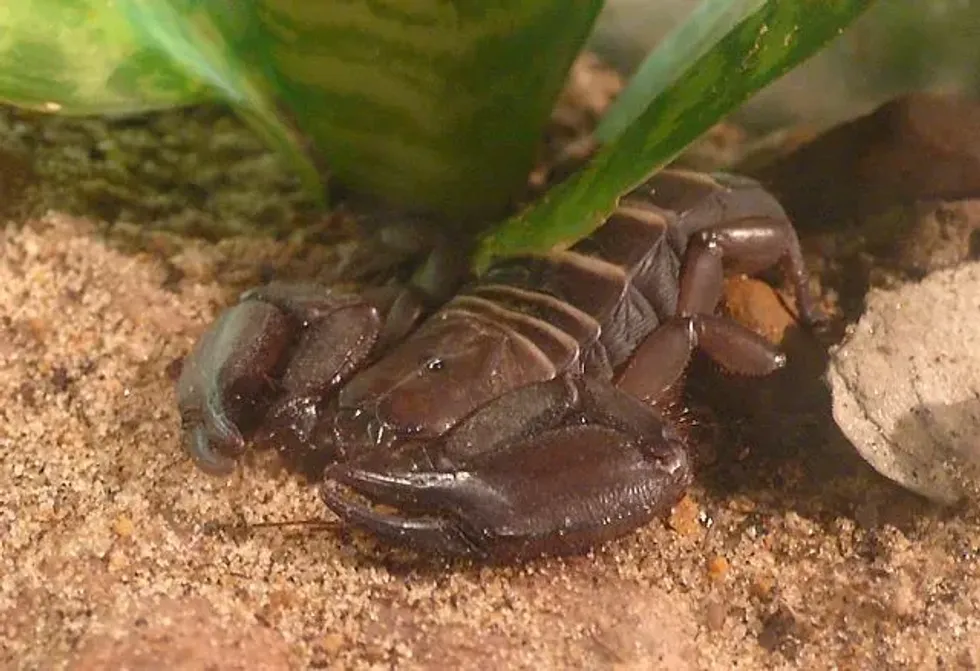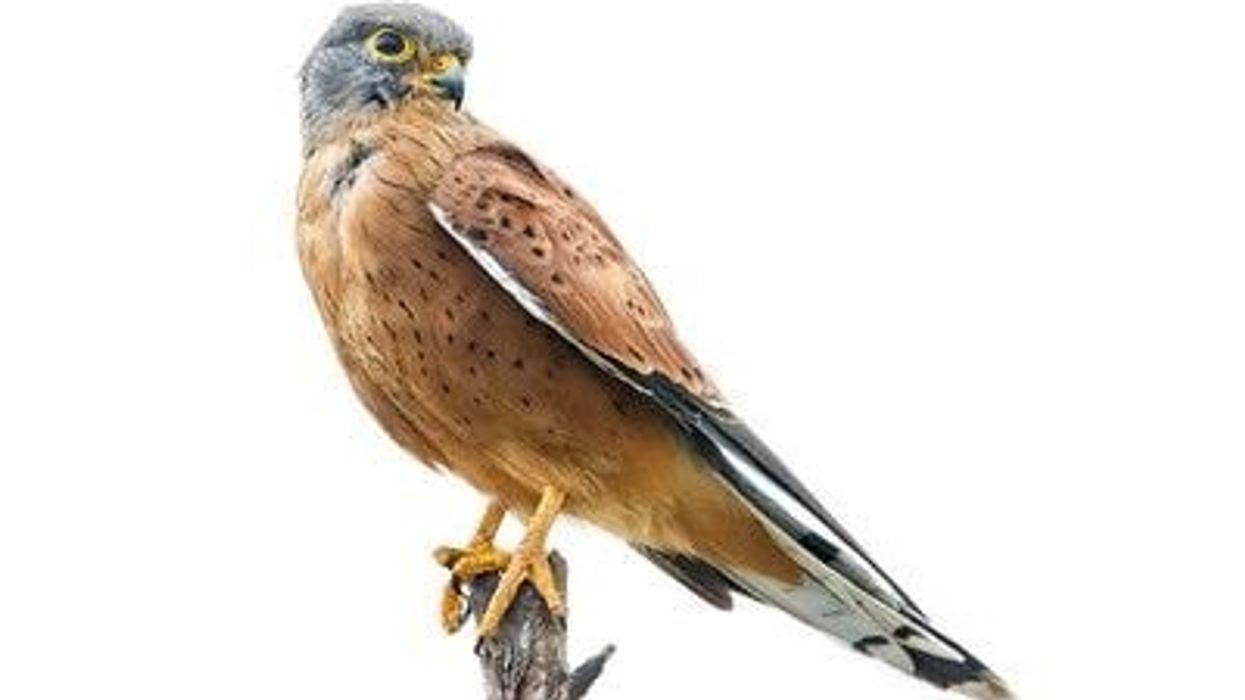This species attained fame when they were given the title of the longest recorded scorpion in the world. At that time, there were no others whose length was above 4 in (10.16 cm) except for the African flat rock scorpion, which is around 8 in (20.32 cm) in length.
However, this title has recently been awarded to another species of scorpion, the giant forest scorpion (Heterometrus swammerdami).
This gigantic species is quite famous in the exotic pet market as many people keep them as their personal pets because they do not contain a large amount of poison in the body, except for a little mild sting similar to the sting of a bee.
Here on our page, we have a lot of interesting facts on the flat rock scorpion for everyone to enjoy. Let's have a look at these interesting facts, and if you do like these, you can read our Southern devil scorpion facts and emperor scorpion facts.
Flat Rock Scorpion Interesting Facts
What type of animal is a flat rock scorpion?
The flat rock scorpion (Hadogenes troglodytes) belongs to the arachnid family and is a species of African Scorpions.
What class of animal does a flat rock scorpion belong to?
Hadogenes troglodytes belong to the class Arachnida.
How many flat rock scorpions are there in the world?
The exact population of this giant scorpion is not yet estimated. The reason behind this is that these scorpions are rare to find in the wild, but they are regularly caught to be sold to be in captivity. Their population might be stable in the world.
Where does a flat rock scorpion live?
Hadogenes troglodytes are the native species of the regions of southern Africa. Other subspecies broods of this scorpion, like the olive-keeled flat rock scorpion and the giant banded flat rock scorpion, are also distributed in regions of Africa.
What is a flat rock scorpion's habitat?
These scorpions can are mostly seen found in rocky areas. These scorpions are found hiding behind the rocks or cracks of bushland and grassland during the daytime. As dawn arrives, they come out from hiding behind rocks and prey on crickets until dusk arrives. The temperature for the flat rock scorpion habitat needs to be warm.
Who do flat rock scorpions live with?
All the species of scorpions stay solitary during the length of their life. Sometimes, these creatures spend their whole lives in one territory and behind rocks that they find when they mature. These scorpions are seen together only during the mating period or in captivity.
How long does a flat rock scorpion live?
The flat rock scorpion lifespan is one of the longest recorded. These creatures can live up to the age of 25 years in the wild, and a pet flat rock scorpion can live for more than 30 years.
How do they reproduce?
The female flat rock scorpion has a larger body than the male. However, their tail is much shorter.
For the breeding process, the males engage by grabbing the pincers of females and perform a body shaking action to impress the females. While doing so, they substrate their spermatophore, which the females use for completing the mating process.
After the process is done, the pair separate from each other, and the female raises the young alone. The flat rock scorpion pregnancy lasts for around ten days, after which the young gigantic flat rock scorpion broods are born.
What is their conservation status?
The conservation status of the flat rock scorpion species is Not Evaluated yet by the International Union for Conservation of Nature because the data is deficient, there is no available information that tells us the status of these scorpions.
Flat Rock Scorpion Fun Facts
What do flat rock scorpions look like?

The body structure of the flat rock scorpion is quite strange. These scorpions have flattened heads, bodies, and claws, whereas the tail of this scorpion is slender in shape with a small stinger to sting at the end of the tail.
There are bristles that look quite stiff on its body. The male and female flat rock scorpions are easily distinguished by the size of their tails as males have a longer tail than females.
Their claws are large, which helps them hold onto their prey easily, even through cracks and small places.
The color of the scorpion's body can vary as they have different color forms. The colors of the body can be red, black, brown, blue, green, and gray.
How cute are they?
It's all a matter of perspective, but typically creatures like the giant South African flat rock scorpion are considered creepy and scary to look at, although many people find them cute enough to keep them as a pet.
How do they communicate?
In order to communicate with each other, the flat rock scorpion uses vibrations and pheromones. These creatures rarely communicate with each other, and the main thing for which they communicate is the mating process.
How big is a flat rock scorpion?
The size of a flat rock scorpion is usually around 6-8 in (15-20 cm). These scorpion species are larger than the common scorpion, which is around 3 in (7.5 cm) in length.
How fast can a flat rock scorpion move?
This species can move very fast indeed. They have slender bodies and six legs that help them with quick movements and enable them to hide behind rocks in just some seconds. The specific range of speed that the flat rock scorpion can move has not been estimated yet by researchers.
How much does a flat rock scorpion weigh?
The average weight of this species can be up to 0.09 lb (42.5 g).
What is the name of the males and females of the species?
There are no sex-specific names for this species.
What would you call a baby flat rock scorpion?
There is no particular name for a baby flat rock scorpion.
What do they eat?
The flat rock scorpion's diet consists of small insects like crickets, worms, and mollusks. When the scorpion is young, they mostly feed on micro crickets. As the scorpion grows in size, they start to prey on larger insects. One interesting fact is that this species only needs to eat two or three times a week!
Are they dangerous?
Everyone assumes that the flat rock scorpion species is dangerous, but this scorpion is the least dangerous species among the scorpions. Yes, this scorpion is considered to have a semi-aggressive nature, but this is typical when threatened.
Other than that, this scorpion does not have that much poison in its body, which can kill a human. They might sting during dangerous situations, but their sting is not dangerous to a human. It is just like the sting of bees.
Would they make a good pet?
The flat rock scorpion has been known to be kept as an exotic pet, as this scorpion is easy to handle, very obedient in behavior, and does not contain dangerous poison in its body. As these creatures rarely sting humans, they can become wonderful pets.
Did you know...
As you know, scorpions look like marine lobsters, but these creatures belong to the family of mites, spiders, and ticks.
How do flat rock scorpions see?
Although you can see the flat rock scorpion's eyes clearly on its head, these creatures are almost blind. The eyes are just for show as they cannot detect anything with them.
The scorpion locates their food of choice, insects, through the use of the sensitive hairs that are on their legs. These hairs help them to detect the distance and direction of their prey.
Flat rock scorpion care
If you are to keep a scorpion as a pet, it is recommended to keep them inside a glass tank as they are agile climbers and can climb from other cages. The temperature of a scorpion's habitat should be kept warm preferably.
It is easy to take care of them by giving them small requirements like rocks for shelter, a bowl of water, and food two to three times a week.
Here at Kidadl, we have carefully created lots of interesting family-friendly animal facts for everyone to discover! Learn more about some other arthropods from our imperial moth facts and rove beetle facts pages.
You can even occupy yourself at home by coloring in one of our free printable flat rock scorpion coloring pages.










